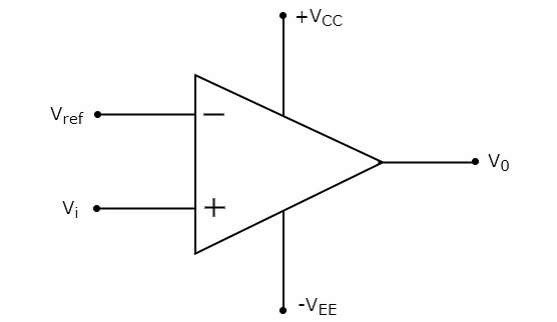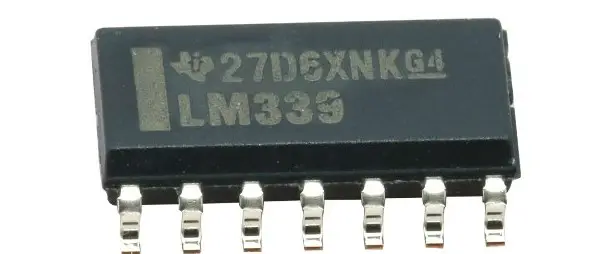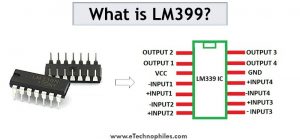Last updated on March 22nd, 2024 at 01:19 pm
LM339 is one of the widely used voltage comparator IC from the series of LMx39x comparators. It consists of four independent voltage comparators, designed in such a way that it can work from a single source of power supply.
It is used in various applications like analog to digital converter (ADC), measuring instruments, etc. In this article, we will see the pinout and specifications of LM339. We will also discuss its working and the other equivalents of this IC.
Table of Contents
LM339 pinout

The table below gives the description of each pin present in LM339 IC.
| Pin No. | Pin Name | Description |
| 1 | OUT Pin | Out pin of the first comparator |
| 2 | OUT Pin | Out pin of the second comparator |
| 3 | Vcc | The power supply of the comparator |
| 4 | IN- | Negative input pin of the second comparator |
| 5 | IN+ | Positive input pin of the second comparator |
| 6 | IN- | Negative input pin of the first comparator |
| 7 | IN+ | Positive input pin of the first comparator |
| 8 | IN- | Negative pin of the third comparator |
| 9 | IN+ | Positive pin of the third comparator |
| 10 | IN- | Negative pin of the fourth comparator |
| 11 | IN+ | Positive pin of the fourth comparator |
| 12 | GND | Ground pin |
| 13 | OUT | The output pin of the fourth comparator |
| 14 | OUT | The output pin of the third comparator |
What is LM339?
LM339 is a voltage comparator IC that consists of 14 pins and four independent voltage comparators. This specially designed comparator can work from a single power supply. It is available in different packages like TSSOP-14, SOIC-14, and PDIP-14.
It can even work from a dual power supply, but the voltage difference between the two supplies must be between 2 V to 36 V. The comparator even operates well for split power supplies.
It compares two inputs that are applied at the input terminal and shows the output in a digital form. Based on their amplitudes, it indicates which of the input is higher.
One of the distinctive features of the LM339 comparator is that the Input Common-Mode Voltage Range (ICMR) includes a ground when it works from a single voltage source.
Here are the main features of LM339 Voltage comparator IC:
- Low supply current i.e. 1.1 mA
- Low input bias current i.e. 25 nA
- Low input offset current i.e. 5 nA
- Wide range of single supply voltage values (+3 Volts to 36 Volts)
- Low output saturation voltage i.e. 250 mW
- Low input offset voltage i.e. 1 mV
What is a voltage comparator?
In electronic circuits, a voltage comparator is used to compare two input voltages and shows which one of the two is greater.

A reference voltage signal is first applied to the inverting input of the circuit. The voltage signal of an unknown value is then applied to the non-inverting input of the circuit.
Now, the comparator compares this unknown signal with the reference signal and gives an output. It can be either of the following:
| Input Voltage | Output Voltage |
| Equal to the reference voltage | Zero |
| Greater than the reference voltage | Positive |
| Lesser than the reference voltage | Negative |
What are the types of voltage comparators?
Depending upon the Op-Amp terminal to which the input signal is applied, there are two types of Voltage comparators: Inverting and Non-inverting comparators.
Inverting Comparator
It is an op-amp-based comparator where
- A reference voltage is applied to its non-inverting terminal
- Input voltage is applied to its inverting terminal
Non-Inverting Comparator
It is an op-amp-based comparator where
- A reference voltage is applied to its inverting terminal
- Input voltage is applied to its non-inverting terminal
How does LM339 work?
The working of the LM339 voltage comparator is similar to other comparators’ ICs. LM339 IC has four voltage comparators. Each comparator of this IC consists of three pins. These are Non-inverting(+IN), Inverting (-IN), and Output.
To understand its working, consider one comparator out of the four comparators present on this IC. Let V1 and V2 be the two input voltages that need to be compared and V0 be the output of the comparator.

Suppose the voltage V1 is connected to pin 5 which is the non-inverting input (+IN) of the comparator. And the voltage V2 is connected to pin 4, which is the inverting input (-IN) of the comparator.
Case 1: If the voltage V2 is greater than voltage V1, then the output will be logic zero.
V2>V1 then Vo = 0V or GND
Case 2: If the voltage V1 is greater than the voltage V2, then the output will be logic Vcc.
V1>V2 then Vo = VCC
Specifications
The specifications of LM339 IC are explained below:
| Parameter | Value |
| Compatible with logic forms | TTL, CMOS, MOS |
| Operating temperature | -25°C to 85°C |
| Junction temperature | 150°C |
| Low input bias current | 25nA |
| Low Input offset current | ±5nA |
| Low supply current | 1.1 mA |
| Single power supply range | +3.0 V to +36 V |
| Dual power supplies range | +18V to -18V |
| Low input offset voltage | 1mV |
| The low output saturation voltage | 130 mV at 4mA |
Equivalents of the LM339?
The equivalent of LM339 voltage comparator IC are:
- LM2901
- LM239
- LM311
- LM324
- LM397
- LM139
What is the difference between LM339 & LM324?
The difference between LM339 and LM324 is that:
The output of the LM339 comparator is an open collector, while the LM324 has a complementary output.
Due to the open collector, the output load can be connected to any voltage level, irrespective of the voltage provided to the IC. While in the case of the LM324, the load will always operate at the voltage given to the IC.
Please note that an open collector only sinks the current whereas the complementary output can either source or sink.
**To know more about open collector output, read this article: Open collector
Applications
It is used in several applications. Some of them are mentioned below:
- Driving CMOS
- Transducer Amplifier
- Voltage comparators
- Industrial oscillators
- Peak detectors
- Crystal controlled oscillator
- Negative reference comparator
- Driving TTL
- Low-frequency Om-amp
- Measuring instruments
- Logic voltage translation
- Automotive
- Limit comparators
- Power supervision
- Square wave pulse generation and time delay generation
- Analog to digital conversion of signals
LM339 packages
This IC is available in different packages in the market which are listed below:
The TSSOP-14 package (LM339DTBR2G)

The PDIP-14 package (LM339NG)

The SOIC-14 package (LM339DG)

Datasheet
To download the LM339 IC datasheet, click here. By reading this datasheet, you can find detailed information about the IC.
FAQs
What is the voltage of IC LM339?
The operating voltage of the LM339 quad voltage comparator IC typically ranges from 3 volts to 36 volts.
How to check LM339?
To check the LM339, visually inspect for damage, ensure proper power supply, apply input signals, and measure output using an oscilloscope or multimeter. Expected behavior includes output transitioning between high and low states. Deviations may indicate an issue with the IC.
What is the difference between LM324 and LM339?
The LM324 is a quad operational amplifier IC containing four op-amps, commonly used for signal processing tasks like amplification and filtering. Conversely, the LM339 is a quad voltage comparator IC with four comparators, utilized for comparing voltage levels in applications such as threshold detection and level sensing. While both ICs serve different functions, they are integral components in various electronic circuits.
What is LM339 quad differential comparator?
The LM339 is a quad voltage comparator IC, meaning it contains four independent voltage comparators in one package. It’s commonly used in electronics for comparing voltage levels and making decisions based on those comparisons.

